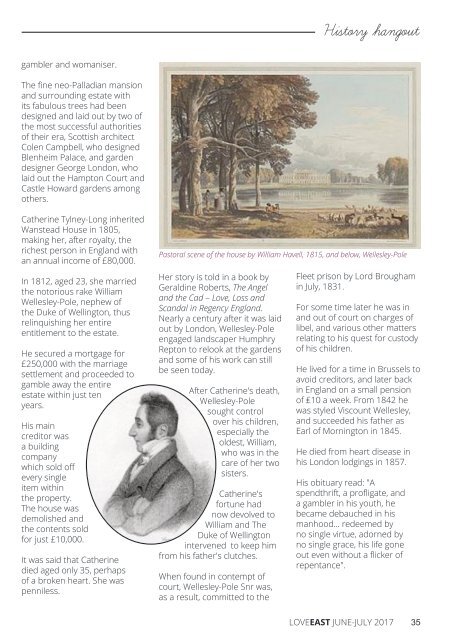June-July
You also want an ePaper? Increase the reach of your titles
YUMPU automatically turns print PDFs into web optimized ePapers that Google loves.
History hangout<br />
gambler and womaniser.<br />
The fine neo-Palladian mansion<br />
and surrounding estate with<br />
its fabulous trees had been<br />
designed and laid out by two of<br />
the most successful authorities<br />
of their era, Scottish architect<br />
Colen Campbell, who designed<br />
Blenheim Palace, and garden<br />
designer George London, who<br />
laid out the Hampton Court and<br />
Castle Howard gardens among<br />
others.<br />
Catherine Tylney-Long inherited<br />
Wanstead House in 1805,<br />
making her, after royalty, the<br />
richest person in England with<br />
an annual income of £80,000.<br />
In 1812, aged 23, she married<br />
the notorious rake William<br />
Wellesley-Pole, nephew of<br />
the Duke of Wellington, thus<br />
relinquishing her entire<br />
entitlement to the estate.<br />
He secured a mortgage for<br />
£250,000 with the marriage<br />
settlement and proceeded to<br />
gamble away the entire<br />
estate within just ten<br />
years.<br />
His main<br />
creditor was<br />
a building<br />
company<br />
which sold off<br />
every single<br />
item within<br />
the property.<br />
The house was<br />
demolished and<br />
the contents sold<br />
for just £10,000.<br />
It was said that Catherine<br />
died aged only 35, perhaps<br />
of a broken heart. She was<br />
penniless.<br />
Pastoral scene of the house by William Havell, 1815, and below, Wellesley-Pole<br />
Her story is told in a book by<br />
Geraldine Roberts, The Angel<br />
and the Cad – Love, Loss and<br />
Scandal in Regency England.<br />
Nearly a century after it was laid<br />
out by London, Wellesley-Pole<br />
engaged landscaper Humphry<br />
Repton to relook at the gardens<br />
and some of his work can still<br />
be seen today.<br />
After Catherine's death,<br />
Wellesley-Pole<br />
sought control<br />
over his children,<br />
especially the<br />
oldest, William,<br />
who was in the<br />
care of her two<br />
sisters.<br />
Catherine's<br />
fortune had<br />
now devolved to<br />
William and The<br />
Duke of Wellington<br />
intervened to keep him<br />
from his father's clutches.<br />
When found in contempt of<br />
court, Wellesley-Pole Snr was,<br />
as a result, committed to the<br />
Fleet prison by Lord Brougham<br />
in <strong>July</strong>, 1831.<br />
For some time later he was in<br />
and out of court on charges of<br />
libel, and various other matters<br />
relating to his quest for custody<br />
of his children.<br />
He lived for a time in Brussels to<br />
avoid creditors, and later back<br />
in England on a small pension<br />
of ₤10 a week. From 1842 he<br />
was styled Viscount Wellesley,<br />
and succeeded his father as<br />
Earl of Mornington in 1845.<br />
He died from heart disease in<br />
his London lodgings in 1857.<br />
His obituary read: "A<br />
spendthrift, a profligate, and<br />
a gambler in his youth, he<br />
became debauched in his<br />
manhood... redeemed by<br />
no single virtue, adorned by<br />
no single grace, his life gone<br />
out even without a flicker of<br />
repentance".<br />
LOVEEAST JUNE-JULY 2017 35

















